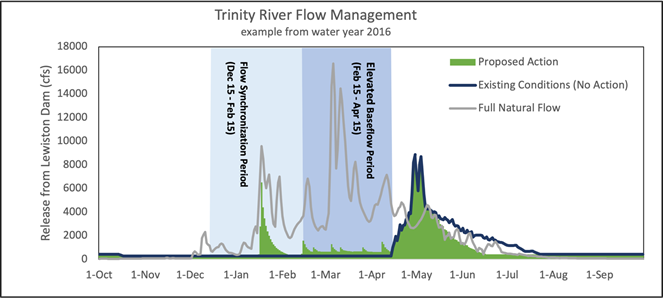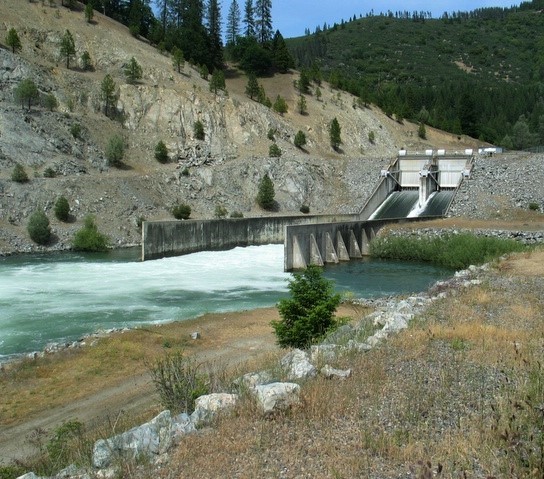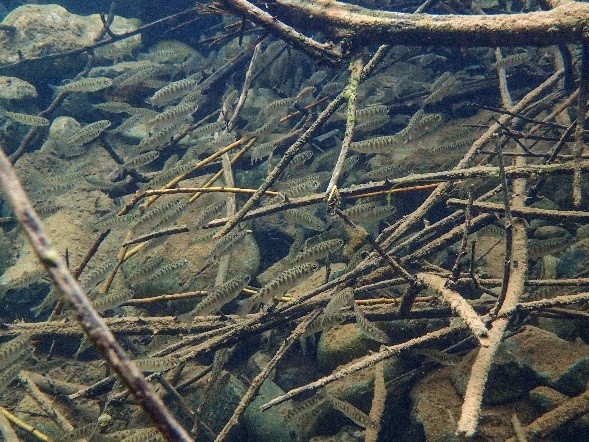Historically, the Trinity River Restoration Program (TRRP) has held winter flows at a static 300 cubic foot per second winter base flow. In keeping with our adaptive management mandate, during water year 2023 the TRRP partially implemented the Variable Flow Project, a science-driven approach to managing restoration flows across a broader period of the year, as described below. The approach is fully described in Abel et al. (2022) Trinity River Winter Flow Project.
Project Background
Following the 2000 Record of Decision (ROD), the U.S. Department of Interior (DOI) established the Trinity River Restoration Program (TRRP) to restore the fisheries of the Trinity River affected by dam construction and related diversions of the Trinity River Division of the Central Valley Project. The Trinity River has also been impacted by past mining and timber harvest activities in the watershed, and these conditions are collectively addressed through TRRP’s restoration efforts.
Administered by the U.S. Bureau of Reclamation (Reclamation), the TRRP is a partnership of federal, state and Tribal resource agencies, and Trinity County. TRRP works to restore the processes and attributes of an ecologically functioning river system, which should, in turn, recover diminished salmon and steelhead populations while retaining Trinity and Lewiston Dams’ deliveries of water and power to California’s Central Valley.
There are five primary components of TRRP’s river restoration work:
- Variable annual instream flows: releasing water from Lewiston Dam, based on the water year type1, to mimic natural Trinity River flows and interact with downstream areas to enhance conditions for all life stages of fish and wildlife. These variable annual instream flows are also sometimes called “restoration releases”.
- 1 TRRP uses five water year types to determine how much water will be available to the Trinity River each year. The five water year types are: Critically Dry, Dry, Normal, Wet, and Extremely Wet. A wetter water year means more water is available for restoration flow releases.
- Channel rehabilitation: restoring the functional floodplain of the river, which has been channelized and simplified by managed river flows and mining.
- Sediment management: reintroducing gravel (aka coarse sediment) to the river. Gravel provides spawning areas for salmon and provides other habitat benefits. Gravel entering the river system upstream of the dam is blocked from being transported to the Trinity River below Lewiston Dam, creating a gravel deficit in the river over time. TRRP resupplies the river with gravel to make up for the dam’s impact in blocking new gravel supplies that would otherwise be provided naturally.
- Watershed restoration: addressing negative impacts that have resulted from poor land management in the basin. Watershed restoration activities include decreasing the input of fine sediment from Trinity River tributaries that can clog spawning gravels and fill deep areas of the river.
- Adaptive management: monitoring, evaluating, and improving the effectiveness of river restoration actions.
The TRRP has been exploring changes toward how variable annual instream flows are managed (Primary TRRP Component #1) with existing ROD water from Lewiston Dam. Since the implementation of the ROD through 2022, variable flow releases (aka restoration releases) occurred after the water year type is determined in mid-April2. An approved hydrograph (i.e. water release schedule) developed by TRRP determined how much water was released daily during this period of elevated flows. Variable releases typically extended well into summer before returning to baseflow conditions and then remained at baseflow until the following April when a new water year was determined.
- 2 The water year type is determined by the Department of Water Resources’ B120 (ca.gov) water supply forecast.
The past approach to implementing variable flows in the Trinity River resulted in cold water releases from Lewiston Dam that were out of sync from when the pre-dam Trinity River would have naturally received seasonal peak flows. Undammed tributaries to the Trinity River naturally flow higher during winter storm events, and as high elevation snowpack melts in early spring. Thus, natural contributions to the Trinity River from its tributaries were often receding by the time ROD flow releases from Lewiston Dam occurred after mid-April.
While those restoration flows were better than no flows at all, the asynchrony between flow management and the natural variability of pre-dam flows had cascading impacts on the river’s form and ecology, including impacts to young salmon. Pacific salmon’s life history has adapted to the natural seasonal variability of flows for millions of years. Flow management kept river conditions unnaturally cold, which can suppress metabolic rates during the key period of growth for young salmon. Later in the spring, the unnaturally cold river might delay environmental cues that trigger smolts to outmigrate to the ocean before conditions in the lower Klamath become too warm to support salmon migration.
Variable Flow Goals and Objectives
The purpose and need for flow variability is to refine the timing of restoration flows using the principle of Adaptive Environmental Assessment and Management (AEAM) to better meet geomorphic, fish habitat, and temperature objectives of the ROD. Moving a portion of the ROD volume released from Lewiston Dam to the winter period is intended to have the following benefits to the natural character of the Trinity River:
- Time restoration releases from Lewiston Dam to better match natural flow variability during winter and spring runoff events. Coinciding natural flows and Lewiston dam releases would enhance natural cleaning and transport of river gravels.
- Limit the impact that cold water from the dam has on the growth of juvenile salmon by shifting a portion of ROD water from Lewiston Dam to the winter period.
- Allow the river to naturally warm earlier in the season than currently occurs to provide the environmental cues smolts rely upon in timing their outmigration to the ocean.
- Provide elevated flows before salmon fry emergence to increase food availability and higher river levels after emergence to increase access to floodplain nursery habitats.
- Move ROD water allocations earlier to maintain more consistent lake levels in Trinity Reservoir through the summer months.
Description of Variable Flow Actions
Shift a portion of the ROD water for release during the winter to two distinct periods termed the Flow Synchronization Period and the Elevated Baseflow Periods (Figure 1).
Flow Synchronization Period: Between December 15 and February 15, ROD water equivalent to 60,000-acre-feet would be released from Lewiston Dam when forecasting tools at downstream gages anticipate a rise in river levels of 4,500 to 12,000 cubic feet per second (cfs). The maximum scheduled flow from Lewiston Dam during this period would not exceed 6,500 cfs. The optimal combination of natural and dam-regulated flows to the Trinity River resulting from this flow synchronization would be adjusted downward, as necessary, to prevent flooding or damage to downstream properties.
Elevated Baseflow Period: Between February 15 and April 15, ROD water will be released from Lewiston Dam based on the Department of Water Resource’s B120 water supply forecast. Using the B120 90% exceedance forecasts will prevent the overuse of ROD water should the water year end up being drier than expected. During this three month period, hydrographs will be developed by TRRP to schedule the elevated baseflow releases, one month at a time.
After April 15, the remaining ROD water would be released to the Trinity River using the same methodology that currently exists for the scheduling of restoration flows. No changes to summer baseflow (450 cfs) or winter baseflow (300 cfs) are anticipated in the near future.
The maximum winter release of ROD water under these Variable Flow actions will differ from year to year based on the water year type, as follows:
- 60,000 acre-feet in a Critically Dry water year,
- 80,000 acre-feet in a Dry water year,
- 120,000 acre-feet in a Normal water year,
- 180,000 acre-feet in a Wet water year, and
- 220,000 acre-feet in an Extremely Wet water year

Figure 1: Winter Flow Variability Actions Compared to Existing Conditions (No Action), Using the 2016 Wet Water Year as an Example.
The blue line represents the hydrograph that was implemented in 2016. Green represents the timing of hypothetical water releases that could occur with Winter Flow Variability. Grey line represents the full natural flow. The full natural flow is the unimpeded contributions from the blocked watershed area above Lewiston Dam. It shows the timing of when water would have naturally been contributed to Trinity River if not impounded by Trinity Lake.
Further Information
- Abel et al. (2022) Trinity River Winter Flow Project
- TRRP Synthesis Reports Web Page
- Reports that contrast current winter baseflows with more natural flows:
- Buxton, T. H. 2021. History of fine sediment and Its Impacts on physical processes and biological populations in the restoration reach of the Trinity River, CA. Report TRRP-2021-1 for the Trinity River Restoration Program (TRRP). TRRP, Weaverville, California.
- Gaeuman, D. and R. Stewart. 2017. Sediment transport in the Trinity River, CA: data synthesis 2004-2015. Report TR-TRRP-2017-1 for the Trinity River Restoration Program (TRRP). TRRP, Weaverville, California.
- Thomas Gast & Associates. 2021. Analysis and model evaluation of long-term data collected at the Willow Creek outmigrant trap. Report 20190910YTFP for the Trinity River Restoration Program (TRRP). Thomas Gast & Associates Environmental Consultants, Arcata, California.
- External Web Page: Trinity River Benthic Macroinvertebrate Drift project


